There’s no shortage of things to do or sights to see in New Orleans, site of the 82nd Scientific Sessions, which will be held June 3-7, 2022, at the Ernest N. Morial Convention Center.
Founded by the French and later ruled by the Spanish, New Orleans is a one-of-a-kind city that’s jam-packed with European, Southern, Creole, and Cajun influences. The city’s charms can be enjoyed on a bus tour, a guided walking tour, a food tour, or an architecture tour. Or you can venture out on your own by grabbing a map and setting out on foot. Here are just a few of the can’t-miss sights New Orleans has to offer.
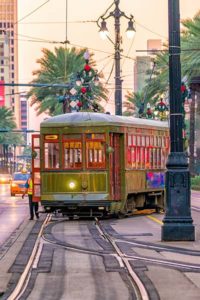 Streetcars
Streetcars
Operated by the New Orleans Regional Transit Authority (RTA), the four distinct lines that make up the New Orleans Streetcar system are a fun, easy way to experience the city. Each line begins downtown and runs through culturally rich neighborhoods you might not otherwise see.
The St. Charles Streetcar is the most famous line and has been in service since 1835, making it the oldest continuously running streetcar line in the world. It runs along St. Charles Avenue and is the busiest route in the RTA system, as both local commuters and tourists use it.
“Jazzy Passes” are available for $3 and allow you to ride all day. Check out the RTA website for a list of places to buy passes, or download the RTA GoMobile app to pay your fare by phone.
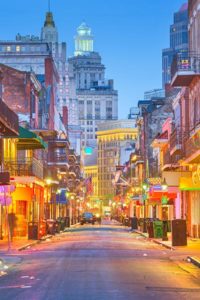
French Quarter
The French Quarter is the oldest neighborhood in New Orleans. It comprises the 13 blocks along the Mississippi River from Canal Street to Esplanade Avenue, and the seven to nine blocks northwest to North Rampart Street.
Famous for its bars and nightlife, the most well-known street in the French Quarter is Bourbon Street, which helped earn New Orleans the nickname “The Big Easy.” Two of the more famous French Quarter establishments are Pat O’Brien’s Bar, the first dueling piano bar and home of the city’s famous Hurricane cocktail, and Jean Lafitte’s Old Absinthe House, which moved locations during Prohibition but returned to its original building in 2004.
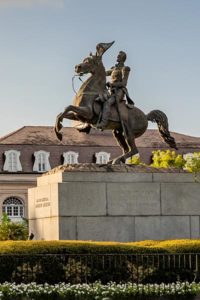 Jackson Square & St. Louis Cathedral
Jackson Square & St. Louis Cathedral
Jackson Square is named for the bronze statue of former U.S. President Andrew Jackson at its center. More than 2 million visitors and locals visit the picturesque, 2.5-acre square each year. An iron fence surrounding the square features the for-sale work of local artists.
The streets surrounding the four sides of the square feature historically and culturally significant buildings, most notably the St. Louis Cathedral and Café du Monde, home of the city’s famous powder sugar-coated beignets and chicory coffee.
St. Louis Cathedral is the oldest continuously active Roman Catholic Cathedral in the U.S. It was originally built in 1727 and dedicated to King Louis IX of France, known as “the Crusading King.” It burned during the great fire of 1794 and was rebuilt, reaching completion in the 1850s. It serves as the mother church of the Archdiocese of New Orleans and sits between the Cabildo and the Presbytere, which house the Louisiana State Museum.
 Garden District
Garden District
Developed between 1832 and 1900, the Garden District is one of the best-preserved collections of historic mansions in the Southern U.S. Wealthy newcomers were drawn to the area and built opulent homes that serve as a reminder of New Orleans’ prosperity during the 19th century.
The land the district sits on originally comprised several plantations that were sold to wealthy settlers who didn’t want to live in the crowded French Quarter. The area was first developed so that each house was surrounded by a large garden, giving the district its name. By the 20th century, as uptown New Orleans became more urban, the district’s large lots were subdivided.
The St. Charles Streetcar line runs between downtown and the Garden District.
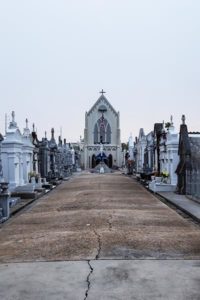
Cemeteries
Much of New Orleans sits below sea level, which makes burying the dead an issue. The earliest residents learned this the hard way when they watched the buried coffins of their loved ones rise to the surface thanks to the city’s high water table. The solution was to entomb the deceased in artfully decorated marble chambers above ground, creating some of the most hauntingly beautiful cemeteries in the world. New Orleans features at least a dozen such cemeteries that serve as the final resting places of voodoo queen Marie Laveau, musician Al Hirt, and Civil War general P.G.T. Beauregard. You can explore the cemeteries on your own or on a guided tour.
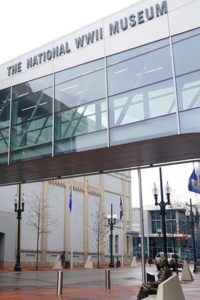
WWII Museum
The National WWII Museum takes visitors inside the story of “the war that changed the world.” It features riveting exhibits, multimedia experiences, and a sweeping collection of artifacts and oral histories, mainly focused on contributions made by the U.S. to the Allied victory in World War II. Formerly known as The National D-Day Museum, the WWII Museum is located in the Central Business District.
[sub-post-content]

